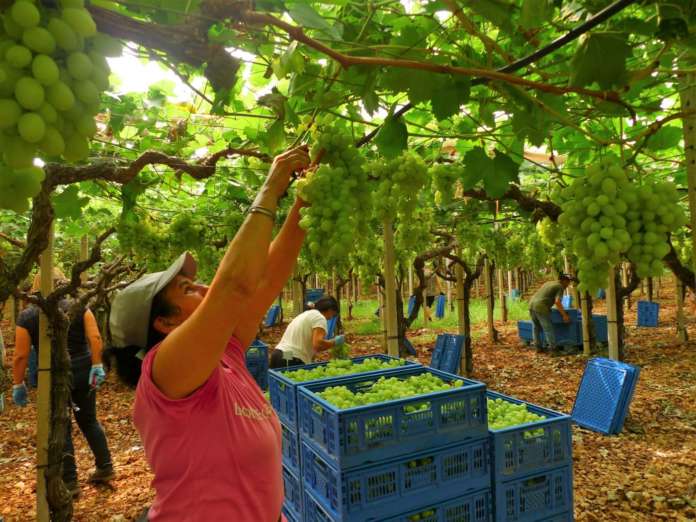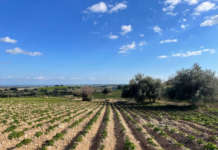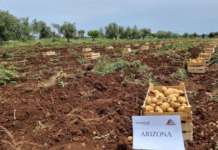È partita la campagna di raccolta dell’uva da tavola, di cui l’Italia è il principale produttore a livello europeo nonché il terzo esportatore a livello mondiale, dopo Perù e Paesi Bassi. I dati di mercato descrivono un settore in cui, sui banchi di vendita dominano ormai per il 70% le varietà seedless, ottenute sempre più frequentemente grazie al lavoro di breeding italiano. La rivoluzione nel mondo dell’uva da tavola verte sulla ricerca sfrenata di nuove varietà che soddisfino i desideri del consumatore. Le aziende sposano la causa del rinnovo varietale rincorrendo le varietà più promettenti in un gioco dove spesso il cerino rimane in mano alla grande distribuzione.
Tanti, troppi i nomi delle varietà presenti sul mercato al punto da disorientare il consumatore che spesso si dimostra impreparato o limitato alla sola differenza tra i diversi colori e alla presenza o meno dei semi.
Lungo la filiera una parte importante è riservata al confezionamento che influisce in maniera decisiva sulla commercializzazione e sulle esportazioni, specialmente quelle di lungo raggio. Determinante per la qualità del prodotto la catena del freddo, grazie all’utilizzo di tunnel di abbattimento rapido in fase di conferimento e di moderni sistemi di confezionamento (Winter Package) come quelli visti presso l’OP Pignataro di Noicattaro. A differenza della Puglia, che avanza sotto tutti i punti di vista, la Sicilia soffre un ritardo, finora non colmato, dovuto a un rinnovo varietale lento, problemi strutturali mai risolti e, negli ultimi due anni, avversità climatiche che hanno sfiancato il comparto. La competitività del prodotto sui mercati internazionali rimane bassa e il prodotto fatica a decollare. In considerazione dei cambiamenti determinati dal riscaldamento globale, si può facilmente ipotizzare che il futuro di questo comparto passi attraverso l’innovazione varietale guidata da quelle varietà tolleranti allo stress idrico a cui si aggiungeranno quelle che richiedono minori operazioni colturali data la difficoltà nel reperire manodopera. Un obiettivo non facile specie per i produttori più piccoli considerati gli alti costi previsti per il rinnovo di un areale (fino a 100 mila euro tra piantumazione delle barbatelle e allestimenti). Il mercato mondiale, secondo i dati Oiv, la Cina è il primo paese produttore (e consumatore) di uva da tavola, con circa 9 milioni di tonnellate prodotte, seguito dall’India con 2 milioni e dall’Italia.
L’uva da tavola continua ad essere il prodotto di punta anche dell’emisfero australe, con Perù, Cile e Sudafrica primi tre esportatori mondiali. Nella campagna 2022-23 per la prima volta il Cile, pioniere in questo settore e leader assoluto per decenni, ha però dovuto cedere il primato di primo esportatore mondiale al Perù che ha esportato quasi 600 mila tonnellate di prodotto, raddoppiando in meno di sette anni le sue esportazioni. I problemi climatici degli ultimi anni, il rinnovo delle colture e una forte riconversione varietale hanno ridotto, infatti, il potenziale di esportazione del Cile.
Bene l’export nazionale con ampi margini di crescita
Puglia e Sicilia rappresentano il 94% della produzione italiana con una produzione pari a oltre un miliardo di chili e 665 milioni di euro in campagna; oltre 700 milioni di euro anno il valore delle esportazioni, pari al 14% dell’export nazionale di ortofrutta. Un mercato secondo solo alle mele per importanza.
Il 46% dell’export del prodotto è destinato principalmente all’Europa (Germania, Francia, Svizzera, Nord Europa), mentre solo 1,5% è diretto nei paesi extra Ue.
Secondo i dati diffusi da Ismea, i margini di crescita per l’export italiano possono essere enormi. In cinque anni il fatturato potrebbe crescere fino a 1,2 miliardi di euro (+60% vs 2022) se fossero messa in campo le corrette iniziative (incoming e promozione, lavoro di squadra tra istituzioni e produttori).
Identikit del prodotto: bianca, seedless e confezionata
L’uva da tavola bianca mantiene salda la leadership sui banchi della grande distribuzione organizzata. Se nella prima parte dell’ultimo decennio (2013-2020) la sua presenza rappresentava il 55% delle referenze, nell’ultimo biennio (2021-2022) è salita al 69% delle referenze. Nell’ultimo periodo si registra, inoltre, la diminuzione delle richieste per le varietà a bacca rossa (a quota 22% delle referenze) e a bacca nera (a quota 9% delle referenze).
Dopo la pandemia, in particolare, si è registrato il sorpasso delle referenze a peso imposto o confezionato che hanno toccato il 51%. Ciò a scapito di quelle con semi, che sono scese al 31% e che sono vendute quasi esclusivamente sfuse. Rimane poi un’importante quota di “non classificate” (pari al 18%) in quanto non sono disponibili al consumatore indicazioni in merito alla varietà né tantomeno alla presenza o assenza di semi. Si tratta di un importante balzo in avanti, se si considera che appena pochi anni fa il consumo domestico del prodotto confezionato era pari appena al 15%.
Questa crescita così importante è indubbiamente collegata al canale di acquisto, ma anche e soprattutto alla crescente importanza delle varietà senza semi e al percepito dei consumatori.
Un ruolo sempre più importante per l’uva da tavola, è dato dalla crescente quota di acquisti compiuti dalla gdo. Complessivamente iper, super, superette e discount rappresentano il 78% dei volumi totali acquistati in Italia nel 2022.
Apo Conerpo mette a regime il sistema
Apo conerpo, principale Op di ortofrutta europea che riunisce 51 cooperative e oltre seimila soci produttori e la sua business unit Naturitalia, commercializza il prodotto di un numero importante di aziende socie del territorio pugliese tra cui Noacoop di Noicattaro (Bari). A queste fornisce supporto, anche in campo, sul fronte dell’innovazione varietale con l’indicazione anche delle varietà club da mettere a dimora. Le cooperative lavorano il prodotto negli stabilimenti di confezionamento sul territorio e consegnano direttamente alla società partner che provvede alla parte commerciale. Un esempio concreto di messa a terra di obiettivi comuni.
Un progetto di valorizzazione territoriale
La Puglia, prima regione italiana per la produzione di uva da tavola, sceglie il territorio per la promozione del prodotto. E quanto si propone di fare attraverso Uva Regina, il progetto sottoscritto dagli otto comuni più importanti a livello produttivo: Noicattaro, Adelfia, Casamassima, Mola di Bari, Rutigliano,Turi, nel Barese, Castellaneta e Grottaglie, in provincia di Taranto. La costituzione di una rete tra i Comuni che punta a valorizzazione e tutelare il prodotto uva da tavola insieme ai territori coinvolti nella sua produzione è una iniziativa senza precedenti per il comparto nazionale. E quanto ha affermato l’assessore regionale all’Agricoltura, Donato Pentassuglia, nel corso della presentazione del progetto, sottolineando anche il supporto della città metropolitana di Bari e della Regione Puglia. Giacomo Suglia, amministratore di Ermes Fruit a Noicàttaro, nonchè presidente di APEO, associazione pugliese di produttori ed esportatori ortofrutticoli, si dimostra soddisfatto il progetto che unisce il mercato tramite i buyer, il mondo produttivo e il territorio. Le novità dei prossimi mesi a supporto del sistema dell’uva da tavola pugliese riguardano anche gli assetti logistici. Donato Pentassuglia, assessore all’agricoltura della regione Puglia, ha annunciato da fine settembre l’avvio del terminal cargo nell’aeroscalo tarantino di Grottaglie, un progetto che si rivolge all’agroalimentare in generale e all’uva da tavola solo per la parte finale della stagione. •
—-
The evolution of table grapes
The markets are dominated by seedless varieties and supply chains attentive to the sustainability of production. The territory is the asset on which to focus in order to enhance and promote this product
The table grape harvesting campaign has started. Italy is the main producer of this fruit in Europe as well as the third exporter in the world, after Peru and the Netherlands, which, however, operates as a global sorting market and not as a Country of production.
Market data describe a sector in which, on sales counters, seedless varieties now dominate by 70%; they are more and more frequently obtained thanks to Italian breeding work.
The revolution in the world of table grapes focuses on the unbridled search for new varieties that meet consumer desires. Companies embrace the cause of varietal renewal by chasing the most promising varieties in a game where large-scale retailers often become the biggest losers.
There are many, too many names of the varieties on the market, to the point of disorienting the consumer, who often proves to be unprepared or limited only to the simple difference between the different colours and the presence or absence of seeds.
Along the supply chain, an important part is reserved for packaging, which has a decisive influence on marketing and exports, especially long-haul ones. The cold chain is decisive for the quality of the product, thanks to the use of rapid blast chilling tunnels during the delivery phase and modern packaging systems (Winter Package), such as those seen at the PO Pignataro in Noicattaro (Bari) – around thirty companies between Puglia and Sicily for a total area of over 400 hectares of cultivation.
Unlike Puglia, which is progressing from all points of view, Sicily suffers from a gap, which has not been closed yet, due to a slow varietal renewal, structural problems that have never been resolved and, in the last two years, climatic adversities that have exhausted this sector. The competitiveness of the product on international markets remains low and the product struggles to take off.
Considering the changes brought about by global warming, it can easily be hypothesized that the future of this sector will pass through varietal innovation guided by the varieties that are tolerant to water stress, to which those that require fewer cultivation operations will be added, given the difficulty in finding labour on the market.
Not an easy goal, especially for smaller producers, considering the high costs foreseen for the renewal of an area (up to 100,000 Euros between planting the vine shoots and setting up the marquees).
According to data provided by an Independent Organism of Appraisal, China is the leading producer (and consumer) Country of table grapes, with around 9 million tonnes produced, followed by India, with 2 million, and Italy.
Table grapes continue to be the leading product also in the southern hemisphere, with Peru, Chile, and South Africa as the top three world exporters. In the 2022-23 campaign, for the first time Chile, pioneer in this sector and absolute leader for decades, however had to cede its primacy as world’s first exporter to Peru, which exported almost 600,000 tonnes of product, doubling its exports in less than seven years. In fact, the climatic problems of recent years, the renewal of crops, and a strong varietal conversion have reduced Chile’s export potential.
Puglia and Sicily represent 94% of Italian production, with a production of over one billion kilos and 665 million Euros in the countryside; over 700 million Euros per year is the value of exports, equal to 14% of national fruit and vegetable exports. This market is second only to apples in importance.
46% of product exports are mainly destined for Europe (Germany, France, Switzerland, Northern Europe), while only 1.5% is directed to non-EU Countries.
According to data released by Ismea, the growth margins for Italian exports can be enormous. In five years, turnover could grow up to 1.2 billion Euros (+60% compared to 2022) if the right initiatives were put in place (incoming and promotion, teamwork between institutions and producers).
White table grape maintains its leadership on the counters of large-scale retail trade. If in the first part of the last decade (2013-2020) its presence represented 55% of the references, in the last two years (2021-2022) it has risen to 69% of references. In the last period there has also been a decrease in requests for red berried varieties (22% of references) and black berried (9% of references).
After the pandemic, in particular, an overtaking of imposed or packaged weight references, which reached 51%, was recorded. This to the detriment of varieties with seeds, which have dropped to 31% and are sold almost exclusively in bulk. There is also an important share of ‘unclassified’ grapes (equal to 18%), as no indications are available to the consumer regarding the variety or the presence or absence of seeds.
This is an important leap forward, if we consider that just a few years ago the domestic consumption of packaged products was just 15%. This significant growth is undoubtedly linked to the purchasing channel, but also and above all to the growing importance of seedless varieties and the perception of consumers.
An increasingly important role for table grapes is given by the growing share of purchases made by large-scale retail trade. Overall superstores, supermarkets, minimarkets, and discount stores represent 78% of the total volumes purchased in Italy in 2022.
A territorial enhancement project
Puglia, the first Italian region for the production of table grapes, has chosen the territory for the promotion of the product. This is what it proposes to do through ‘Uva Regina’ (Queen grape), the project signed by the eight most important municipalities in terms of production: Noicattaro, Adelfia, Casamassima, Mola di Bari, Rutigliano, Turi, in the Bari area; Castellaneta and Grottaglie, in the province of Taranto. The establishment of a network between the Municipalities that aims at enhancing and protecting the table grape product together with the territories involved in its production is an unprecedented initiative for the national sector.
This is what the regional Councillor for Agriculture, Donato Pentassuglia, said during the presentation of the project, also underlining the support of both metropolitan city of Bari and Puglia region. Giacomo Suglia, administrator of Ermes Fruit in Noicattaro, as well as president of APEO, Apulian association of fruit and vegetable producers and exporters, is satisfied with this project, which unites the market through buyers, the productive world, and the territory.
Apo Conerpo puts the system in place
Apo Conerpo, the main European fruit and vegetable PO, which brings together 51 cooperatives and over six thousand producer members and its Naturitalia business unit, markets the product of a significant number of member companies in the Apulian area, including Noacoop in Noicattaro (Bari). It provides them support, even in the field, in terms of varietal innovation with indications also of the club varieties to be planted. The cooperatives process the product in the packaging plants in the area and deliver it directly to the partner company that takes care of the commercial part. A concrete example of pursuing common goals.









